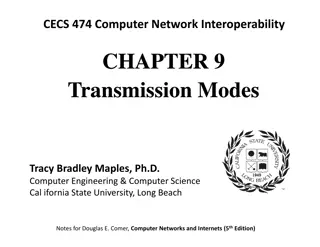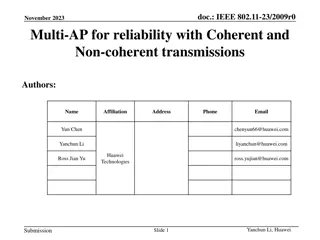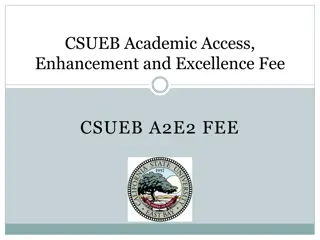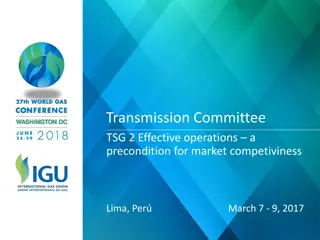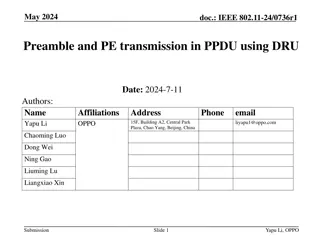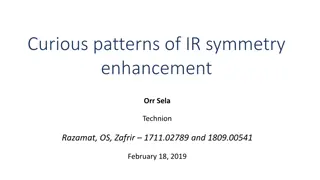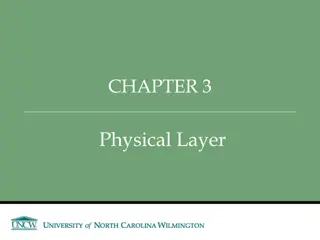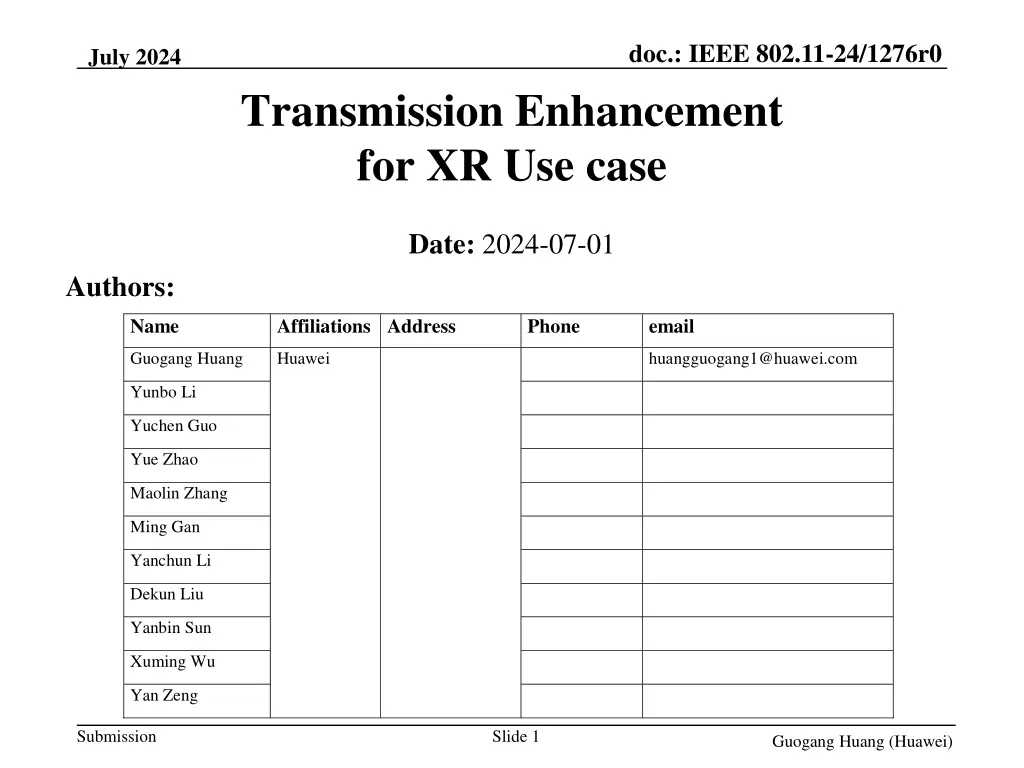
IEEE 802.11-24/1276r0 Transmission Enhancement for XR Use Case
"Learn about the proposed transmission enhancement for XR use cases in IEEE 802.11-24/1276r0 document. Explore how the scheme supports low E2E latency and improved data transmission between devices via AP relay and direct links. The transparent and non-transparent schemes are discussed, focusing on maintaining packet integrity and enhancing communication efficiency."
Download Presentation

Please find below an Image/Link to download the presentation.
The content on the website is provided AS IS for your information and personal use only. It may not be sold, licensed, or shared on other websites without obtaining consent from the author. If you encounter any issues during the download, it is possible that the publisher has removed the file from their server.
You are allowed to download the files provided on this website for personal or commercial use, subject to the condition that they are used lawfully. All files are the property of their respective owners.
The content on the website is provided AS IS for your information and personal use only. It may not be sold, licensed, or shared on other websites without obtaining consent from the author.
E N D
Presentation Transcript
doc.: IEEE 802.11-24/1276r0 July 2024 Transmission Enhancement for XR Use case Date: 2024-07-01 Authors: Name Affiliations Address Phone email Guogang Huang Huawei huangguogang1@huawei.com Yunbo Li Yuchen Guo Yue Zhao Maolin Zhang Ming Gan Yanchun Li Dekun Liu Yanbin Sun Xuming Wu Yan Zeng Submission Slide 1 Guogang Huang (Huawei)
doc.: IEEE 802.11-24/1276r0 Introduction XR use-case Encompassing the case where the two devices (i.e., remote device like XR headset, and device for computation offloading such as laptop) are connected through the same AP Need to support low End-to-End (E2E) latency A proxy SCS mechanism is proposed in [1-3] Enhanced TXOP sharing mechanisms are proposed. [4-5] AP AP relay link STA A STA B Direct link Submission Slide 2 Guogang Huang (Huawei)
doc.: IEEE 802.11-24/1276r0 Motivation The transmission between STA_A and STA_B can be via either the AP relay link or the direct link. Considering the mobility of STA_A, the delay performance of the direct link (i.e. one-hop delay) may be better than the one of the relay link (i.e. two-hop delay). One potential enhancement is to allow the data transmission can be quickly switched between the AP relay link and the direct link without the packet loss. Or aggregate the data transmission through the AP relay link and the direct link if both STA_A and STA_B are multi-radio MLDs. In this contribution, we propose two candidate schemes, i.e. one is transparent for the associated AP, the other one is non-transparent for the associated AP. AP AP relay link {SNS1,PTK1} {SNS2,PTK2} {SNS3,TPK3} STA A STA B Direct link Submission Slide 3 Guogang Huang (Huawei)
doc.: IEEE 802.11-24/1276r0 Transparent Scheme In order to maintain a common BA scoreboard and reorder buffer when the data transmission is switched from the direct link to the AP relay link, the transmitter (e.g. STA_A) shall send the packet to the destination STA (e.g. STA_B) with the following procedure and rules: Step 1. Construct the MPDU (protected by TPK) as it will be sent through the direct link, e.g. RA STA_B MAC address TA STA_A MAC address A3 BSSID TID #a, SN#m Step 2. Encapsulate the above MPDU into a Data frame with the following setting and transmitted to the recipient STA through the AP (See Appendix for details) RA BSSID TA STA_A MAC address A3 STA_B MAC address TID #b, SN#n Submission Slide 4 Guogang Huang (Huawei)
doc.: IEEE 802.11-24/1276r0 Transparent Scheme (Cont.) In order to allow the TDLS transmitter to know the receive status of MSDUs and shift the BA scoreboard window through the AP relayed link, define TDLS BAR and BA Management frames which are encapsulated in Data frames and transmitted to the TDLS peer STA through the associated AP. Table. TDLS BAR Management frame Table. TDLS BA Management frame Order Information Order Information 1 Category 1 Category 2 Action 2 Action 3 Dialog Token 3 Dialog Token 4 BAR Control 4 BA Control 5 BAR Information 5 BA Information Submission Slide 5 Guogang Huang (Huawei)
doc.: IEEE 802.11-24/1276r0 Transparent Scheme (Cont.) The TDLS transmitter may monitor the link qualities of the direct link and the relay link and decide when to switch the data transmission from one link to the other link. Define TDLS Relay Link Measurement Request and Response Management frames Which can be encapsulated in a Data frame and transmitted to the TDLS Peer STA through the AP Which also can be transmitted through the TDLS direct link When the TDLS peer STA receives a TDLS Relay Link Measurement Request, then it shall report the link quality with the associated AP May include the link quality between STA_A and AP within the TDLS Relay Link Measurement Request Include the link quality between STA_B and AP within the TDLS Relay Link Measurement Response Submission Slide 6 Guogang Huang (Huawei)
doc.: IEEE 802.11-24/1276r0 Non-transparent Scheme Define Relay ADDBA Request and Response frames Which are the same as the current ADDBA Request and Response frames except including a Peer Address or AID field When the AP forwards the received Relay ADDBA Request and Response, it is only allowed to change the Buffer Size Value, as shown in the right figure. The AP shall maintain a separate BA scoreboard and a reordering buffer for the relayed data Keep the SN and the TID of the relayed MPDU unchanged Hence, the AP shall recognize relayed data frame from the non-relayed data frame according to the TA and Address 3 The relayed data frame is the data frame between STA_A and STA_B The other data frame is named as the non-relayed data frame Submission Slide 7 Guogang Huang (Huawei)
doc.: IEEE 802.11-24/1276r0 Non-transparent Scheme (Cont.) The transmitter may monitor the link qualities of the direct link and the AP relay link. Then it decides when to use the direct link for transmission Define a new Relay Link Measurement Request/Response frames. corresponding frame exchange procedure is shown as the right figure. Peer Address Link quality, e.g. RSSI Similarly, STA_A may transmit a Relay BAR frame to the AP to acquire the status of MPDUs destination to STA_B. The AP shall respond with a Relay BA frame Which are the same as the current BAR and BA frames except including a Peer Address field And the Submission Slide 8 Guogang Huang (Huawei)
doc.: IEEE 802.11-24/1276r0 Conclusions In this presentation, we propose two candidate schemes in order to facilitate the data transmission can be quickly switched or aggregated between the AP relay link and the direct link. The proposed transparent scheme can be easily incorporated into the current TDLS protocol. Submission Slide 9 Guogang Huang (Huawei)
doc.: IEEE 802.11-24/1276r0 References [1] 11-23/1958r0 Proxy QoS management for XR use cases (Guoqing Li, Meta) [2] 11-23/0073r0 Thoughts on Proxy SCS (Guogang Huang, Huawei) [3] 01-24/1885r1 End-to-end QoS with SCS (Duncan Ho, Qualcomm) [4] 11-23/1387r1 TXOP sharing extensions for XR use-cases (Dibakar Das, Intel) [5] 11-24/0668r1 Data Forwarding within TXOP for XR Use Cases (Seongho Byeon, Samsung) Submission Slide 10 Guogang Huang (Huawei)
doc.: IEEE 802.11-24/1276r0 Appendix Usage of EtherType 89-0d Submission Slide 11 Guogang Huang (Huawei)




